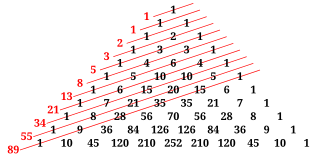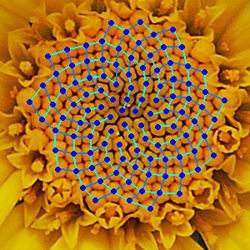热门问题
时间线
聊天
视角
斐波那契數
無限的斐波那契數列中的整數 来自维基百科,自由的百科全书
Remove ads
費波那契數(意大利語:Numero di Fibonacci),又譯為菲波拿契數、菲波那西數、斐氏數、黃金分割數、費氏數列。所形成的數列稱為費波那契數列(意大利語:Successione di Fibonacci),又譯為菲波拿契數列、菲波那西數列、斐氏數列、黃金分割數列、費氏數列。這個數列是由意大利數學家斐波那契在他的《算盤書》中提出。
此條目需要補充更多來源。 (2014年3月25日) |

- ()
用白話文來說,就是斐波那契數列由0和1開始,之後的斐波那契數就是由之前的兩數相加而得出。首幾個斐波那契數是:
特別指出:0 不是第一項,而是第零項()。
Remove ads
起源
公元1150年印度數學家Gopala和金月在研究箱子包裝物件長寬剛好為1和2的可行方法數目時,首先描述這個數列。在西方,最先研究這個數列的人是比薩的李奧納多(意大利人斐波那契Leonardo Fibonacci, 1175-1250),他描述兔子生長的數目時用上了這數列:

- 第一個月初有一對剛誕生的兔子
- 第二個月之後(第三個月初)牠們可以生育
- 每月每對可生育的兔子會誕生下一對新兔子
- 兔子永不死去
假設在月有兔子總共對,月總共有對。在月必定總共有對:因為在月的時候,前一月(月)的對兔子可以存留至第月(在當月屬於新誕生的兔子尚不能生育)。而新生育出的兔子對數等於所有在月就已存在的對

斐波納契數也是楊輝三角形(即帕斯卡三角形)的每一條紅色對角線上數字的和。
Remove ads
表達式
為求得斐波那契數列的一般表達式,可以藉助線性代數的方法。高中的初等數學知識也能求出。
已知:
- (n≥3)
設
化簡得
比較係數可得:
不妨設
解得:
又因為有,
即為等比數列。
Remove ads
由以上可得:
變形得: 。 令
Remove ads
設,解得。
故數列為等比數列
即。而,
故有
又有
和
可得
得出表達式
,稱比內公式(Binet's Formula)
Remove ads
- 證明,其中為黃金比例,為任意整數
- 若為非負整數
- 當時,,成立
- 當時,,成立
- 設當及時皆成立,即且
- 當時
- 亦成立
- 若為非正整數
- 當時,成立
- 當時,,成立
- 設當及時皆成立,即且
- 當時
- 亦成立
因此,根據數學歸納法原理,此表達式對於任意整數皆成立
Remove ads
稱為「斐波那契Q矩陣」(Fibonacci Q-Matrix)[1]
Remove ads
設為第個月有生育能力的兔子數量,為這一月份的兔子數量。
上式表達了兩個月之間,兔子數目之間的關係。而要求的是,的表達式。
求矩陣的特徵值:λ
根據特徵值的計算公式,我們需要算出來 所對應的解。
展開行列式有:。
故當行列式的值為 0,解得 或 。
Remove ads
將兩個特徵值代入
求特徵向量得
=
=
Remove ads
第一個月的情況是兔子一對,新生0對。
將它分解為用特徵向量表示。
- (4)
用數學歸納法證明
從
- =
可得到
- (5)
將(4) 代入 (5)
根據3
現在在6的基礎上,可以很快求出的表達式,將兩個特徵值代入6中
- (7)
(7)即為的表達式
實際上,如果將斐波那契數列的通項公式寫成,即可利用解二階線性齊次遞迴關係式的方法,寫出其特徵多項式(該式和表達斐波那契數列的矩陣的特徵多項式一致),然後解出=,=,即有,其中為常數。我們知道,因此,解得。
因此得到的一般式:
此一般式對任意整數成立
當為足夠大的正整數時,則
可通過編程觀察斐波那契數列。分為兩類問題,一種已知數列中的某一項,求序數。第二種是已知序數,求該項的值。
可通過遞歸遞推的算法解決此兩個問題。 事實上當相當巨大的時候,O(n)的遞推/遞歸非常慢……這時候要用到矩陣快速冪這一技巧,可以使遞迴加速到O(logn)。
和黃金分割的關係
開普勒發現數列前、後兩項之比,也組成了一個數列,會趨近黃金分割:
斐波那契數亦可以用連分數來表示:
而黃金分割數亦可以用無限連分數表示:
而黃金分割數也可以用無限多重根號表示:
和自然的關係

斐氏數列見於不同的生物學現象[3],如樹的分枝、葉在枝條上的排列、菠蘿聚花果上小單果的排列、[4]雅枝竹的花蕾、正在舒展的蕨葉、松毬的鱗的排列[5]、蜜蜂的家族樹[6][7]。開普勒曾指出斐氏數列存在於自然界,並以此解釋某些花的五邊形形態(與黃金分割率相關)。[8]法國菊的「瓣」(舌狀花)數通常為斐氏數。[9]1830年,K. F. Schimper和A. Braun發現植物的旋生葉序中,連續兩塊葉之間轉過的角度與周角之比,約成整數比時,常出現斐氏數[10],如或[11]。
恆等式
資料來源:[12]
證明以下的恆等式有很多方法。以下會用組合論述來證明。
- 可以表示用多個1和多個2相加令其和等於的方法的數目。
不失一般性,我們假設,是計算了將1和2加到n的方法的數目。若第一個被加數是1,有種方法來完成對的計算;若第一個被加數是2,有來完成對的計算。因此,共有種方法來計算n的值。
計算用多個1和多個2相加令其和等於的方法的數目,同時至少一個加數是2的情況。
如前所述,當,有種這樣的方法。因為當中只有一種方法不用使用2,就即 (項),於是我們從減去1。
- 若第1個被加數是2,有種方法來計算加至的方法的數目;
- 若第2個被加數是2、第1個被加數是1,有種方法來計算加至的方法的數目。
- 重複以上動作。
- 若第個被加數為2,它之前的被加數均為1,就有種方法來計算加至0的數目。
若該數式包含2為被加數,2的首次出現位置必然在第1和的被加數之間。2在不同位置的情況都考慮到後,得出為要求的數目。
- 藉由上述公式,又可推得以下恆等式[註 4]:
數論性質
- 整除,若且唯若整除,其中。
- 任意連續三個菲波那契數兩兩互質,亦即,對於每一個,
在斐波那契數列中,有質數:[14] 2, 3, 5, 13, 89, 233, 1597, 28657, 514229, 433494437, 2971215073, 99194853094755497, 1066340417491710595814572169, 19134702400093278081449423917……
截至2015年,已知最大的斐波那契質數是第104911個斐波那契數,一共有21925個十進制位。不過,人們仍不知道是不是有無限個斐波那契質數。[15]
如§ 公因數和整除關係所述,總能被整除,故除之外,任何斐氏質數的下標必同為質數。由於存在任意長的一列連續合數,斐氏數列中亦能找到連續任意多項全為合數。
大於的斐氏數,必不等於質數加一或減一。[16]
斐波那契數列中,只有3個平方數:0、1、144。[17][18]2001年,派特·奧蒂洛證明,斐氏數中的次方數衹有有限多個。[19]2006年,Y. Bugeaud、M. Mignotte、S. Siksek三人證明,斐波那契數中的次方數只有0、1、8、144。[20]
1、3、21、55為僅有的斐氏三角形數。Vern Hoggatt曾猜想此結論,後來由羅明證明。[21]
斐波那契數不能為完全數。[22]推而廣之,除1之外,其他斐氏數皆非多重完全數[23],任兩個斐氏數之比亦不能是完全數[24]。
斐波那契數列各項模的餘數構成週期數列,其最小正週期稱為皮薩諾周期[25],至多為[26]。皮薩諾週期對不同值的通項公式仍是未解問題,其中一步需要求出某個整數(同餘意義下)或二次有限域元素的乘法階數。不過,對固定的,求解模的皮薩諾週期是週期檢測問題的特例。
推廣
斐波那西數列是斐波那西n步數列步數為2的特殊情況,也和盧卡斯數列有關。
反費波那西數列的遞歸公式如下:
如果它以1,-1開始,之後的數是:1,-1,2,-3,5,-8, ...
即是,
亦可寫成,其中是非負整數。
反費波那西數列兩項之間的比會趨近。
證明,其中是非負整數
- 以表示黃金分割數,則有
- 故,因此
費波那西數列可以用一個接一個的正方形來表現,巴都萬數列則是用一個接一個的等邊三角形來表現,它有的關係。
佩爾數列的遞歸公式為,前幾項為0,1,2,5,12,29,70,169,408,...
應用
1970年,尤裏·馬季亞謝維奇指出了偶角標的斐波那契函數
正是滿足Julia Robison假設的丟番圖函數,因而證明了希爾伯特第十問題是不可解的。

最左一條路徑上的鍵值全為斐氏數。
- 考慮以輾轉相除法求兩個正整數的最大公因數,分析此算法的運行時間。同等輸入規模下,最壞情況(用時最長)發生於輸入為兩個相鄰斐氏數時。[27]
- 歸併排序算法有一多相(polyphase)版本用到斐氏數列,是將未排序的數組分為兩份,長度為相鄰的斐氏數(因此比值接近黃金比)。《計算機程序設計藝術》[頁碼請求]描述了此種多相合併排序的實作方法,適用於以磁帶機為外存的情況。
- 斐波那契樹是一棵二叉樹,其每個節點的左右子樹高皆恰好差1。由此,斐氏樹為AVL樹,且對固定高度而言,是最少節點的AVL樹。此類樹的節點數可寫成斐氏數減1。[28]
- 某些偽隨機數生成器用到斐氏數列。[具體情況如何?]
- 斐波那契堆是一種數據結構,分析其時間複雜度時會用到斐波那契數。
- 斐波那契編碼是以01字串表示正整數的一種方法,負斐波那契編碼與之類似,還可以表示負數。
延伸閱讀
- KNUTH, D. E. 1997. The Art of Computer ProgrammingArt of Computer Programming, Volume 1: Fundamental Algorithms, Third Edition. Addison-Wesley. Chapter 1.2.8.
- Arakelian, Hrant (2014). Mathematics and History of the Golden Section. Logos, 404 p. ISBN 978-5-98704-663-0, (rus.)
- 克裏福德A皮科夫.數學之戀.湖南科技出版社.
參考文獻
註釋
參見
外部連結
Wikiwand - on
Seamless Wikipedia browsing. On steroids.
Remove ads































![{\displaystyle a_{n}={\frac {\sqrt {5}}{5}}\cdot \left[\left({\frac {1+{\sqrt {5}}}{2}}\right)^{n}-\left({\frac {1-{\sqrt {5}}}{2}}\right)^{n}\right]}](http://wikimedia.org/api/rest_v1/media/math/render/svg/bdd45861380dd60d182655318702aea70439dff8)

![{\displaystyle F_{n}={\frac {1}{\sqrt {5}}}[\varphi ^{n}-(1-\varphi )^{n}]}](http://wikimedia.org/api/rest_v1/media/math/render/svg/bee558cfcd137ef42e1682ffbde748dbaa9049b9)



![{\displaystyle {\frac {1}{\sqrt {5}}}[\varphi ^{0}-(1-\varphi )^{0}]={\frac {1}{\sqrt {5}}}[1-1]=0=F_{0}}](http://wikimedia.org/api/rest_v1/media/math/render/svg/2b1b701622c8d471397b1b0aa8a0e5e843d911a7)

![{\displaystyle {\frac {1}{\sqrt {5}}}[\varphi ^{1}-(1-\varphi )^{1}]={\frac {1}{\sqrt {5}}}[\varphi -1+\varphi ]={\frac {1}{\sqrt {5}}}[2\varphi -1]={\frac {1}{\sqrt {5}}}\times {\sqrt {5}}=1=F_{1}}](http://wikimedia.org/api/rest_v1/media/math/render/svg/cac8a776619505f21da34fc5732592f34560e780)


![{\displaystyle F_{k}={\frac {1}{\sqrt {5}}}[\varphi ^{k}-(1-\varphi )^{k}]}](http://wikimedia.org/api/rest_v1/media/math/render/svg/824eaa5312dbcdc7598e2e17597a3abb0afe787e)
![{\displaystyle F_{k+1}={\frac {1}{\sqrt {5}}}[\varphi ^{k+1}-(1-\varphi )^{k+1}]}](http://wikimedia.org/api/rest_v1/media/math/render/svg/7c5a3f0a6cd2d150a82df2e79fe1d4c7a84fb338)

![{\displaystyle {\begin{aligned}F_{k+2}&=F_{k+1}+F_{k}\\&={\frac {1}{\sqrt {5}}}[\varphi ^{k+1}-(1-\varphi )^{k+1}]+{\frac {1}{\sqrt {5}}}[\varphi ^{k}-(1-\varphi )^{k}]\\&={\frac {1}{\sqrt {5}}}[\varphi ^{k+1}+\varphi ^{k}-(1-\varphi )^{k+1}-(1-\varphi )^{k}]\\&={\frac {1}{\sqrt {5}}}\left\{\varphi ^{k}({\color {brown}\varphi +1})-(1-\varphi )^{k}[{\color {green}(1-\varphi )+1}]\right\}\\&={\frac {1}{\sqrt {5}}}\left\{\varphi ^{k}({\color {brown}\varphi ^{2}})-(1-\varphi )^{k}[{\color {green}(1-\varphi )^{2}}]\right\}\\&={\frac {1}{\sqrt {5}}}\left\{\varphi ^{k+2}-(1-\varphi )^{k+2}\right\}\\\end{aligned}}}](http://wikimedia.org/api/rest_v1/media/math/render/svg/1e19a652bec35ae600135d7f28dc6e740618fcd9)

![{\displaystyle {\frac {1}{\sqrt {5}}}[{\color {brown}\varphi ^{-1}}-{\color {green}(1-\varphi )^{-1}}]={\frac {1}{\sqrt {5}}}[({\color {brown}\varphi -1})-({\color {green}-\varphi })]={\frac {1}{\sqrt {5}}}[2\varphi -1]={\frac {1}{\sqrt {5}}}\times {\sqrt {5}}=1=F_{-1}}](http://wikimedia.org/api/rest_v1/media/math/render/svg/067dc5b026bec6465ecce134b5d2bc1c2e19614a)


![{\displaystyle F_{-k}={\frac {1}{\sqrt {5}}}[\varphi ^{-k}-(1-\varphi )^{-k}]}](http://wikimedia.org/api/rest_v1/media/math/render/svg/8e6bb7975c8f8eb405b63222b0eacfb5d1ef0261)
![{\displaystyle F_{-k-1}={\frac {1}{\sqrt {5}}}[\varphi ^{-k-1}-(1-\varphi )^{-k-1}]}](http://wikimedia.org/api/rest_v1/media/math/render/svg/e3eb17ec8fbde65ce2b6bd0381b1893e41c7c6da)

![{\displaystyle {\begin{aligned}F_{-k-2}&=F_{-k}-F_{-k-1}\\&={\frac {1}{\sqrt {5}}}[\varphi ^{-k}-(1-\varphi )^{-k}]-{\frac {1}{\sqrt {5}}}[\varphi ^{-k-1}-(1-\varphi )^{-k-1}]\\&={\frac {1}{\sqrt {5}}}[\varphi ^{-k}-\varphi ^{-k-1}-(1-\varphi )^{-k}+(1-\varphi )^{-k-1}]\\&={\frac {1}{\sqrt {5}}}\left\{\varphi ^{-k-1}({\color {brown}\varphi -1})-(1-\varphi )^{-k-1}[{\color {green}(1-\varphi )-1}]\right\}\\&={\frac {1}{\sqrt {5}}}\left\{\varphi ^{-k-1}({\color {brown}\varphi ^{-1}})-(1-\varphi )^{-k-1}[{\color {green}(1-\varphi )^{-1}}]\right\}\\&={\frac {1}{\sqrt {5}}}\left\{\varphi ^{-k-2}-(1-\varphi )^{-k-2}\right\}\\\end{aligned}}}](http://wikimedia.org/api/rest_v1/media/math/render/svg/f8c2dfd1c8ad510846bb8e2412fe41d99984f141)





















![{\displaystyle {J_{n+1} \choose A_{n+1}}=\lambda ^{n}\cdot \left[{\frac {1}{\sqrt {5}}}\cdot {\begin{pmatrix}1\\{\frac {1}{2}}(1+{\sqrt {5}})\end{pmatrix}}-{\frac {1}{\sqrt {5}}}\cdot {\begin{pmatrix}1\\{\frac {1}{2}}(1-{\sqrt {5}})\end{pmatrix}}\right]}](http://wikimedia.org/api/rest_v1/media/math/render/svg/bc133beb4b93512f07a7d4137d65f3370ef034b0)



![{\displaystyle A_{n+1}={\frac {1}{\sqrt {5}}}\cdot \left\{\left[{\frac {1}{2}}\left(1+{\sqrt {5}}\right)\right]^{n+1}-\left[{\frac {1}{2}}(1-{\sqrt {5}})\right]^{n+1}\right\}}](http://wikimedia.org/api/rest_v1/media/math/render/svg/2a5d474227a68a4e3da154e737496903e5f3ce03)

















![{\displaystyle {\begin{aligned}F_{n}&={\frac {1}{\sqrt {5}}}[\varphi ^{n}-(1-\varphi )^{n}]\\&={\frac {1}{\sqrt {5}}}\left[({\frac {1+{\sqrt {5}}}{2}})^{n}-({\frac {1-{\sqrt {5}}}{2}})^{n}\right]\\\end{aligned}}}](http://wikimedia.org/api/rest_v1/media/math/render/svg/cb84ca1bfe8f1bdc851d380bee094e82b93605ba)
![{\displaystyle F_{n}\approx {\frac {1}{\sqrt {5}}}\varphi ^{n}={\frac {1}{\sqrt {5}}}\cdot \left[{\frac {1}{2}}\left(1+{\sqrt {5}}\right)\right]^{n}\approx 0.4472135955\cdot 1.61803398875^{n}}](http://wikimedia.org/api/rest_v1/media/math/render/svg/50053dc83435d2c5ae69ad1ad31e0f1caf5cf4a7)
![{\displaystyle F_{-n}\approx -{\frac {1}{\sqrt {5}}}(1-\varphi )^{-n}=-{\frac {1}{\sqrt {5}}}\cdot \left[{\frac {1}{2}}\left(1-{\sqrt {5}}\right)\right]^{-n}\approx -0.4472135955\cdot (-0.61803398875)^{-n}}](http://wikimedia.org/api/rest_v1/media/math/render/svg/fd72835a21743b30d3cbb877616c0951db09ee0a)



![{\displaystyle F_{n}={\frac {1}{\sqrt {5}}}\left[\left({\frac {1+{\sqrt {5}}}{2}}\right)^{n}-\left({\frac {1-{\sqrt {5}}}{2}}\right)^{n}\right]={\varphi ^{n} \over {\sqrt {5}}}-{(1-\varphi )^{n} \over {\sqrt {5}}}}](http://wikimedia.org/api/rest_v1/media/math/render/svg/79a3d146bd82cde5406b4eb878d95de2e3c18a32)




















































![{\displaystyle (-1)^{m}=[\varphi (1-\varphi )]^{m}=\varphi ^{m}(1-\varphi )^{m}}](http://wikimedia.org/api/rest_v1/media/math/render/svg/615a16953f76ce8ec3f3b1dd0201f78a946c5b4b)
![{\displaystyle {\begin{aligned}(-1)^{m+1}F_{-m}&=(-1)^{m+1}\times {\frac {1}{\sqrt {5}}}[\varphi ^{-m}-(1-\varphi )^{-m}]\\&=(-1)\times {\color {brown}(-1)^{m}}\times {\frac {1}{\sqrt {5}}}[\varphi ^{-m}-(1-\varphi )^{-m}]\\&=(-1)\times {\color {brown}\varphi ^{m}(1-\varphi )^{m}}\times {\frac {1}{\sqrt {5}}}[\varphi ^{-m}-(1-\varphi )^{-m}]\\&=(-1)\times {\frac {1}{\sqrt {5}}}[\varphi ^{-m+m}(1-\varphi )^{m}-(1-\varphi )^{-m+m}\varphi ^{m}]\\&=(-1)\times {\frac {1}{\sqrt {5}}}[(1-\varphi )^{m}-\varphi ^{m}]\\&={\frac {1}{\sqrt {5}}}[\varphi ^{m}-(1-\varphi )^{m}]\\&=F_{m}\\\end{aligned}}}](http://wikimedia.org/api/rest_v1/media/math/render/svg/e101c296295c3ed0405ddadf099c6c668f2e12a5)


